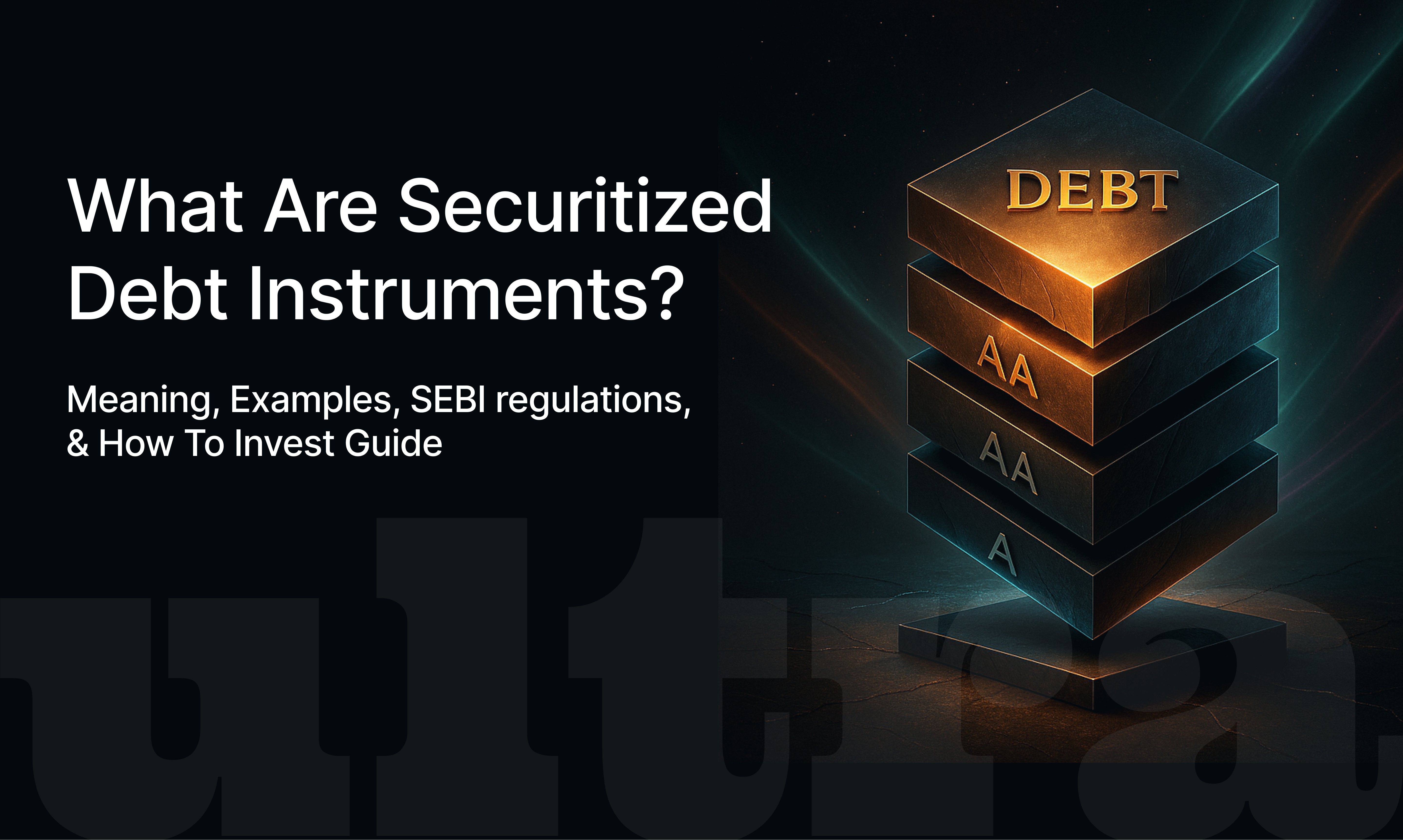What Are Securitized Debt Instruments?
01 August 2025 · Sachin Gadekar
A complete guide to understanding securitized debt instruments, how they work, and how to invest in them in India.

Securitized Debt Instruments Meaning & Structure
Securitized debt instruments (SDIs) are financial products that bundle various types of debt—such as loans, leases, or receivables—and transform them into marketable securities. These instruments are backed by pools of underlying assets, which are structured and sold to investors. The cash flows generated from these assets (like EMI payments or lease rentals) are used to pay returns to investors.
Securitization provides liquidity to lenders and creates alternative investment avenues for retail and institutional investors alike. In India, SDIs have gained traction, especially among investors seeking stable and diversified fixed-income returns.
At its core, securitization is the process of converting illiquid assets into tradable financial instruments. The typical process involves:
Originator (usually a bank or NBFC) pools debt assets (e.g., home loans, car loans).
Special Purpose Vehicle (SPV) is created to hold these assets and issue securities.
Investors buy these securities (SDIs) and earn income from the underlying cash flows.
Trustees ensure legal compliance and manage investor rights.
These securities are often rated by credit rating agencies and come with varied risk-return profiles depending on asset quality, tenure, and structure.
Types of Securitized Debt Instruments
1. Pass-Through Certificates (PTCs):
Investors receive proportional payments as and when cash flows are received from the underlying assets. Common in India’s housing loan and vehicle loan markets.
2. Pay-Through Securities (PTS):
Structured to allow reinvestment of the principal. Investors receive periodic interest, and principal repayment is delayed.
3. Mortgage-Backed Securities (MBS):
Backed specifically by home loans or mortgages.
4. Asset-Backed Securities (ABS):
Backed by other assets such as auto loans, personal loans, or lease receivables.
Securitized Debt Instruments in India
India's securitization market has grown significantly in the past few years, driven by regulatory support and increasing investor appetite. Major NBFCs, fintech lenders, and housing finance companies often use securitization to manage liquidity and risk.
SEBI and the Reserve Bank of India (RBI) regulate these instruments under different frameworks:
SEBI’s Role: Regulates listed securitized debt instruments, disclosure norms, and investor protection.
RBI’s Role: Sets guidelines for banks/NBFCs regarding minimum retention, risk weights, and credit enhancement.
Securitized Debt Instruments SEBI Regulations
SEBI mandates that:
SDIs be listed on recognized exchanges (if publicly issued).
The offer document must disclose risk, asset pool quality, and cash flow projections.
Investors must be given regular performance updates.
The SEBI (Issue and Listing of Securitized Debt Instruments and Security Receipts) Regulations, 2008, govern these instruments in the listed space.
Securitized Debt Instruments Examples
Some common real-world examples include:
Housing Finance Company PTCs: Backed by home loan EMIs.
Fintech Loan ABS: Backed by small-ticket consumer loans.
Commercial Vehicle Loan ABS: Backed by fleet operators’ EMI payments.
Lease Receivable SDIs: Backed by rental payments from leased machinery or office equipment.
Is Securitized Debt an Alternative Investment?
Yes, SDIs fall under the broader umbrella of alternative debt investments. They differ from traditional FDs or bonds in the following ways:
Backed by actual cash-generating assets.
May offer higher returns (8–12% p.a.) based on asset risk.
Typically structured with credit enhancements like first-loss guarantees.
Offer fixed income with predictable cash flows.
How to Invest in Securitized Debt Instruments in India
Investing in SDIs has become easier with the emergence of alternative investment platforms like Ultra. Here's how:
Choose a trusted investment platform (like Ultra) offering curated SDI deals.
Review the asset pool – type of loans, tenor, repayment history.
Check credit rating and credit enhancement structures.
Invest the minimum amount – which can range from ₹10,000 to ₹1 lakh depending on the platform.
Track monthly repayments which reflect in your account.
Platforms like Jiraaf, Grip, and SteadyIncome also offer these investments with regular disclosures and ratings.
Securitized Debt Instruments Minimum Investment
Retail investors: ₹10,000 to ₹25,000 (via curated platforms).
HNIs & Institutions: ₹1 lakh or more for directly subscribing to listed SDIs.
The investment threshold depends on deal type, structure, and platform regulations.
Debt Securitization Process in Brief
Pooling: Lender groups similar loans/assets.
Transfer: Assets moved to SPV.
Structuring: SPV issues SDIs with defined risk tranches (senior, mezzanine, junior).
Issuance: Investors subscribe to SDIs.
Servicing: Loan repayments collected and distributed.
Monitoring: Performance tracked by rating agencies and trustees.
Pros and Cons of Investing in SDIs
Pros:
Attractive fixed returns
Short to medium-term tenure
Diversification across borrower pool
Credit enhancements reduce risk
Monthly income stream
Cons:
Illiquidity (most are not traded actively)
Risk of defaults in asset pool
Requires basic understanding of credit terms
Limited historical performance data for retail deals
FAQs: Securitized Debt Instruments
1. What are securitized debt instruments?
Securitized debt instruments are marketable securities backed by pooled loans or receivables, offering investors fixed returns from underlying cash flows.
2. Is it safe to invest in SDIs in India?
SDIs with credit enhancement and diversified asset pools are relatively safer, though investors should assess risks like defaults and illiquidity.
3. How much can I invest in securitized debt instruments?
Retail investors can invest as low as ₹10,000 via curated platforms. Direct SDI investments may require ₹1 lakh or more.
4. What are the returns on SDIs?
Returns typically range between 8% to 12% p.a., depending on the asset quality, structure, and risk profile.
5. Where can I invest in SDIs?
You can invest in SDIs via platforms like Ultra, Jiraaf, Grip, and other fixed-income marketplaces offering curated deals.